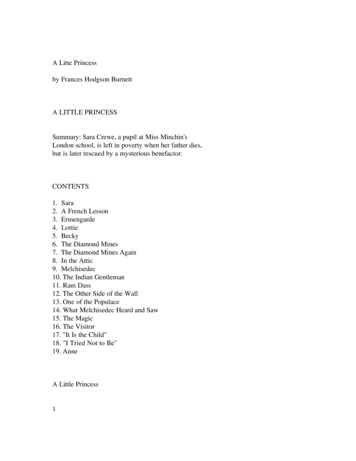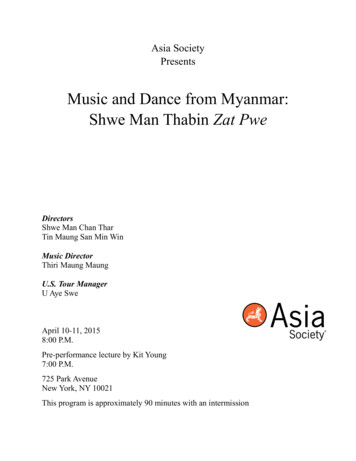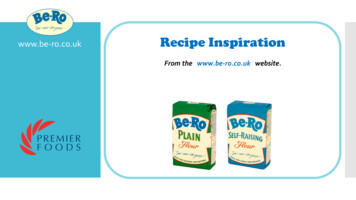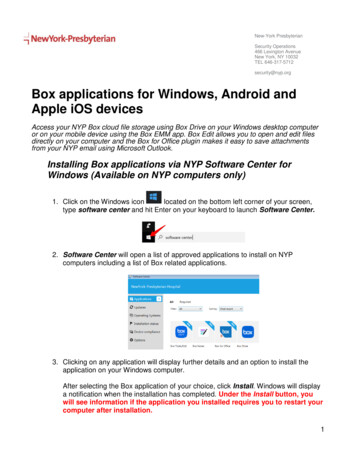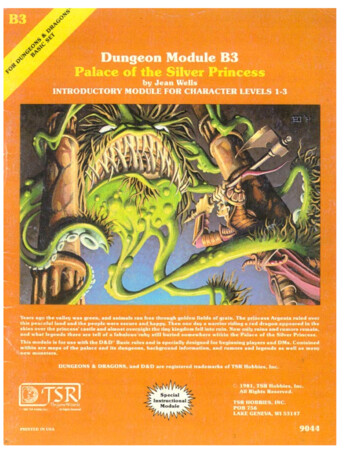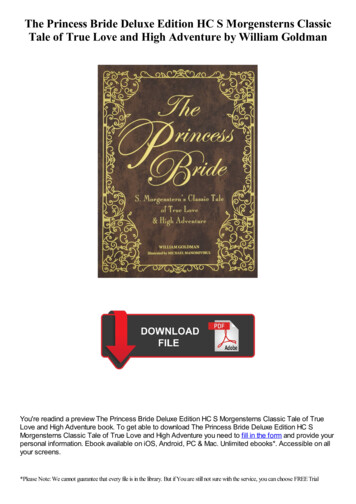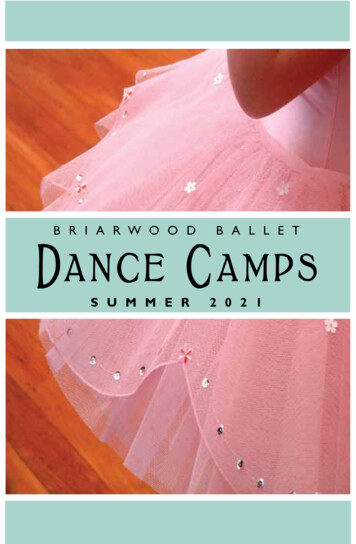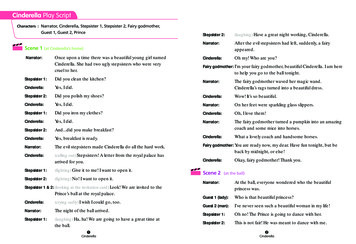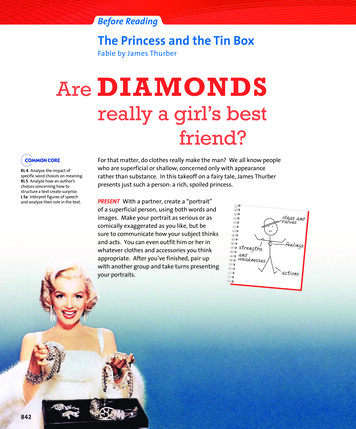
Transcription
Before ReadingThe Princess and the Tin BoxFable by James ThurberAre DIAMONDSreally a girl’s bestfriend?RL 4 Analyze the impact ofspecific word choices on meaning.RL 5 Analyze how an author’schoices concerning how tostructure a text create surprise.L 5a Interpret figures of speechand analyze their role in the text.842For that matter, do clothes really make the man? We all know peoplewho are superficial or shallow, concerned only with appearancerather than substance. In this takeoff on a fairy tale, James Thurberpresents just such a person: a rich, spoiled princess.PRESENT With a partner, create a “portrait”of a superficial person, using both words andimages. Make your portrait as serious or ascomically exaggerated as you like, but besure to communicate how your subject thinksand acts. You can even outfit him or her inwhatever clothes and accessories you thinkappropriate. After you’ve finished, pair upwith another group and take turns presentingyour portraits.ideasvaluesan dstrengthsan dweakn essesfeelingsaction s
Meet the Authortext analysis: parodyHumorist James Thurber is known for his sly, skillful way ofmaking fun of society. “The Princess and the Tin Box” beginsin a very familiar way:Once upon a time, in a far country, there lived a king whosedaughter was the prettiest princess in the world.With that opening sentence, readers immediately recognizethat they have been whisked into a fairy tale. This particulartale, however, is a parody—a literary work that imitatesanother piece of literature in order to poke fun at it. To analyzethis imitation fairy tale, be on the lookout for the followingstylistic techniques: Word Choice: Notice how Thurber imitates the language usedin fairy tales, as in the opening lines above. Exaggeration: Look for characters or situations exaggeratedby the author for comic effect. Irony: Identify ironic plot twists, or moments when Thurberstructures events in a surprising way, allowing them to unfoldvery differently from the way you would expect.As you read, look for evidence of these techniques. Think aboutthe ways in which this parody resembles a traditional fairy taleand the ways in which it does not.reading strategy: predictFairy tales are usually pretty predictable. As you read thisselection, jot down your impressions of the princess. Use thesenotes about the princess’s character to make predictions aboutwhat will happen next in the story. After the last events haveunfolded, ask yourself whether this is the “happily ever after”you anticipated.Complete the activities in your Reader/Writer Notebook.James Thurber1894–1961Early YearsOne of the great humorists of Americanliterature, James Thurber made a career outof poking fun at society. Despite a childhoodeye injury that left him with lifelong visionproblems, Thurber attended college and gotearly jobs as a clerk and then as a journalist.In 1927, the New Yorker, a literary magazine,published one of his stories. He would writefor the magazine for the rest of his life.The New Yorker YearsThe New Yorker gave Thurber his fame, and hegave the magazine much of the sophisticatedstyle it has today. Thurber often provided hisown illustrations to accompany his writing.Although he did not consider himself anartist, his cartoons had a distinctive style andbecame as popular as his stories. Readersloved him for being so funny, but Thurbertook humor seriously. “I write humor the waya surgeon operates,” he said, “because it is alivelihood, because I have a great urge to doit, because many interesting challenges areset up, and because I have the hope it may dosome good.”Last YearsBy the age of 57, Thurber’s childhood eyeinjury had degenerated to almost totalblindness. When his vision began to failcompletely, Thurber started dictating storiesto his secretary. His memory was so sharpthat he could easily compose a 2,000-wordstory in his mind, remember it overnight, anddictate it to his secretary the next day. Hisfriend and fellow-writer E. B. White describedhim this way: “During his happiest years,Thurber didd not write the waya surgeon operates, he wrotethe way a child skips rope,the way a mouse waltzes.”AuthorrOnlineGo to thinkcentral.com.nkcentral.com.KEYWORD:: HML9-843843
rincessand the in oxthejames thurber1020Once upon a time, in a far country, there lived a king whose daughter was theprettiest princess in the world. Her eyes were like the cornflower, her hair wassweeter than the hyacinth, and her throat made the swan look dusty.From the time she was a year old, the princess had been showered withpresents. Her nursery looked like Cartier’s window.1 Her toys were all madeof gold or platinum or diamonds or emeralds. She was not permitted to havewooden blocks or china dolls or rubber dogs or linen books, because suchmaterials were considered cheap for the daughter of a king.When she was seven, she was allowed to attend the wedding of her brotherand throw real pearls at the bride instead of rice. Only the nightingale, withhis lyre of gold, was permitted to sing for the princess. The common blackbird,with his boxwood flute,2 was kept out of the palace grounds. She walked insilver-and-samite slippers to a sapphire-and-topaz bathroom and slept in anivory bed inlaid with rubies. aOn the day the princess was eighteen, the king sent a royal ambassador tothe courts of five neighboring kingdoms to announce that he would give hisdaughter’s hand in marriage to the prince who brought her the gift she likedthe most.The first prince to arrive at the palace rode a swift white stallion and laidat the feet of the princess an enormous apple made of solid gold which he hadtaken from a dragon who had guarded it for a thousand years. It was placedon a long ebony table set up to hold the gifts of the princess’s suitors. Thesecond prince, who came on a gray charger,3 brought her a nightingale madeThurber often sketchedchildlike line drawings likethis one to accompany hisstories. What basic ideasabout love or courtshipdoes he present inthis sketch?aPARODYReread lines 1–14and identify at leasttwo examples ofexaggeration. Whatis the effect of thisstylistic technique?Explain your answer.1. Cartier’s (kär-tyAzP) window: the show window of a well-known jewelry store.2. lyre (lFr) of gold . . . boxwood flute: The nightingale’s voice is likened to a golden harp;the blackbird’s voice is likened to a cheap wooden flute.3. charger: warhorse.844unit 8: author’s style and voiceThe Princess and the Tin Box (1948), James Thurber. renewed1976 by Rosemary A. Thurber. Reprinted by arrangement withRosemary A. Thurber and Barbara Hogenson Agency.
304050of a thousand diamonds, and it was placed beside the golden apple. The thirdprince, riding on a black horse, carried a great jewel box made of platinumand sapphires, and it was placed next to the diamond nightingale. The fourthprince, astride a fiery yellow horse, gave the princess a gigantic heart made ofrubies and pierced by an emerald arrow. It was placed next to the platinumand-sapphire jewel box.Now the fifth prince was the strongest and handsomest of all the fivesuitors, but he was the son of a poor king whose realm had been overrun bymice and locusts and wizards and mining engineers so that there was nothingmuch of value left in it. He came plodding up to the palace of the princess ona plow horse and he brought her a small tin box filled with mica and feldsparand hornblende4 which he had picked up on the way. bThe other princes roared with disdainful laughter when they saw thetawdry5 gift the fifth prince had brought to the princess. But she examinedit with great interest and squealed with delight, for all her life she had beenglutted with precious stones and priceless metals, but she had never seen tinbefore or mica or feldspar or hornblende. The tin box was placed next to theruby heart pierced with an emerald arrow. c“Now,” the king said to his daughter, “you must select the gift you like bestand marry the prince that brought it.”The princess smiled and walked up to the table and picked up the presentshe liked the most. It was the platinum-and-sapphire jewel box, the gift of thethird prince.“The way I figure it,” she said, “is this. It is a very large and expensive box,and when I am married, I will meet many admirers who will give me preciousgems with which to fill it to the top. Therefore, it is the most valuable of all thegifts my suitors have brought me and I like it the best.”The princess married the third prince that very day in the midst of greatmerriment and high revelry.6 More than a hundred thousand pearls were thrownat her and she loved it.Moral: All those who thought the princess was going to select thetin box filled with worthless stones instead of one of the other giftswill kindly stay after class and write one hundred times on theblackboard “I would rather have a hunk of aluminum silicate 7than a diamond necklace.” d4. mica (mFPkE) and feldspar and hornblende (hôrnPblDndQ): three common minerals.5. tawdry (tôPdrC): flashy but cheap.6. revelry (rDvPEl-rC): noisy celebrating.7. aluminum silicate (sGlPG-kAtQ): a basically worthless chemical compound;refers to the mica, feldspar, and hornblende in the prince’s box.846unit 8: author’s style and voicebPARODYThink about the typicalplot, setting, andcharacters of a fairy tale.Find three places whereThurber mimics theseconventions in this story.cPREDICTConsider your impressionof the princess andher reactions to hersuitors’ gifts. Do youthink she will chooseto marry the poor buthandsome prince or oneof the rich, snobby ones?Give reasons for yourprediction.L 5adPARODYSarcasm is a kind ofparticularly cuttingverbal irony that, thoughsometimes humorous,can be used to insult orchastise. In this moral,Thurber playfully chastisesreaders who foresaw adifferent ending, but hedoes so to make a point.What point about humannature does the moralsuggest? Explain.
After ReadingComprehension1. Recall What does the king do on his daughter’s 18th birthday?RL 4 Analyze the impactof specific word choices onmeaning. RL 5 Analyze howan author’s choices concerninghow to structure a text createsurprise.2. Paraphrase Restate the moral of the story in your own words.Text Analysis3. Interpret Irony Reread lines 54–58. How does the end of this story playagainst the reader’s normal expectations of a fairy tale? Explain how theending is ironic, citing evidence from the text.4. Analyze Parody In a chart like the one shown, record examples of the stylistictechniques Thurber uses to parody a fairy tale. Use your completed chart toexplain what human trait or quality Thurber is poking fun at in this story.Stylistic TechniqueExamples from the TextImitation of standard fairy tale languageExaggerationIrony5. Evaluate Predictions How accurately did you predict what would happen atthe end of the story? Explain whether or not you think Thurber intended totake his readers by surprise, and why.6. Make Judgments A parody is an imitation of a writer’s style, a type ofliterature, or a specific work, and is usually designed to make fun ofsomething. In your opinion, is humor an effective tool for social criticism?Can making a joke or commenting on something in a comic way ever helpbring about change? Explain your answer.reading-writing connectionwriting promptrevising tipShort Constructed Response: New EndingDoes your response conveywhat the princess’s new choiceis and why she made it? Is yourresponse humorous? If not,revise your ending. Be sureto include a moral in a stylesimilar to Thurber’s.What would have happened if the princesshad made a different choice? How elsecould this story have ended? In one or twoparagraphs, imagine an alternate ending tothe story and create a new moral to go with it.Try to mimic Thurber’s dry, comic style.Are DIAMONDS really a girl’s best friend?What do you value more than material possessions?the princess and the tin box847
As you read this selection, jot down your impressions of the princess. Use these notes about the princess’s character to make predictions about what will happen next in the story. After the last events have unfolded, ask yourself whether this is the “happily ever after” you anticipated. Go to thinkcent

